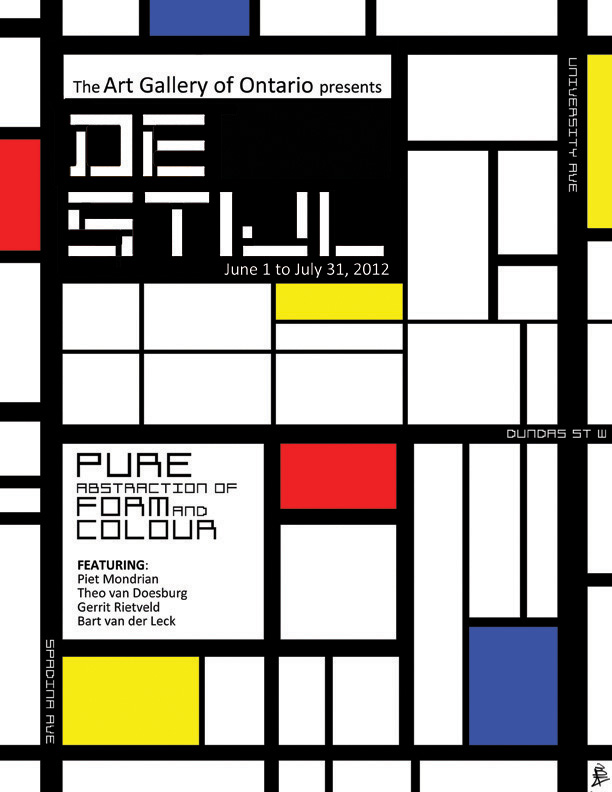Designers: Alessandro Mendini (Pop design movement)
Gerrit Rietveld (De stijl)

Although the De Stijl movement was not the renowned development that cubism or surrealism turned out to be, it nevertheless carried quite an influence into the art world and the design of architectural workings. Despite a fairly fleeting exposure, the De Stijl group could possibly be considered the most important contribution made by the Netherlands towards the development of modern art.
 Design in Italy from the 1950s to the 1990s was integral in setting the foundation for Italian Design today. The work of Alessandro Mendini established a level of thought that has been passed on to the next generation of designers. One of Medini’s greatest contributions to Italian Design is the idea of collaborating with other designers. This allows for a discourse to develop based on shared ideas from different cultural backgrounds. This discourse of knowledge, as well, is something that Mendini strives for in his work. As an intellectual, the theories and ideas of Alessandro Mendini helped define the level of quality in Italian Design, and the importance of knowledge in creating thought provoking, emotional works that reflect their cultural context.
Design in Italy from the 1950s to the 1990s was integral in setting the foundation for Italian Design today. The work of Alessandro Mendini established a level of thought that has been passed on to the next generation of designers. One of Medini’s greatest contributions to Italian Design is the idea of collaborating with other designers. This allows for a discourse to develop based on shared ideas from different cultural backgrounds. This discourse of knowledge, as well, is something that Mendini strives for in his work. As an intellectual, the theories and ideas of Alessandro Mendini helped define the level of quality in Italian Design, and the importance of knowledge in creating thought provoking, emotional works that reflect their cultural context.Focusing on the humanistic side of design and not on mass production, Mendini and other theorists of the time, such as Ettore Sottsass, drew from intellectual ideas as inspiration for their work. Mendini’s attitude of being “more interested in humanity than naturalness” allowed him to produce works that were focused on the specific context in which he was part of (Mendini, 2005).
Design: 1978
Manufacturer: Studio Alchimia, Milan
Size: 107 x 105 x 94; seat height 35 cms
Material: painted wood, painted upholstery
 Few objects seen to sum up a moment in design history more effectively than Gerrit Rieveld’s Red Blue chair. With a plywood seat and back that look like free-floating planes, and a framework of uprights and horizontals, its is widely regarded as an icon of de stijl (the sytle), the avant-garde art and design movement that brought Modernism to the Netherlands in the aftermath of world war 1 – at a time when people were looking forward to rebuilding a new Europe.
Few objects seen to sum up a moment in design history more effectively than Gerrit Rieveld’s Red Blue chair. With a plywood seat and back that look like free-floating planes, and a framework of uprights and horizontals, its is widely regarded as an icon of de stijl (the sytle), the avant-garde art and design movement that brought Modernism to the Netherlands in the aftermath of world war 1 – at a time when people were looking forward to rebuilding a new Europe. The chair’s geometry and primary colours epitomize the pure, harmonious forms advocated by de stijl’s followers and reflect the work of the group’s most famous painter, Piet Mondrain. The original chair, however, was made from unstained wood and the colours were only applied later, probably in the early 1920s. In breaking away from past styles, Rietveld had created a pared-down and totally unfamiliar chair, yet he also regarded it as a practical design. He made it from standard cuts of timber and hoped that it would eventually be mass-produced, but the chair was never produced on a large scale. Some people found its stark lines uncompromising; others complained that the flat wooden seat was simply not comfortable. When Rietveld was told this, he did not disagree, but simply stated, “It’s not really a chair: it’s a manifesto”.
The chair’s geometry and primary colours epitomize the pure, harmonious forms advocated by de stijl’s followers and reflect the work of the group’s most famous painter, Piet Mondrain. The original chair, however, was made from unstained wood and the colours were only applied later, probably in the early 1920s. In breaking away from past styles, Rietveld had created a pared-down and totally unfamiliar chair, yet he also regarded it as a practical design. He made it from standard cuts of timber and hoped that it would eventually be mass-produced, but the chair was never produced on a large scale. Some people found its stark lines uncompromising; others complained that the flat wooden seat was simply not comfortable. When Rietveld was told this, he did not disagree, but simply stated, “It’s not really a chair: it’s a manifesto”.As s plea for a fresh way of looking at furniture design, it is still eloquent.
Referneces:
De stijl - http://www.terraingallery.org/Anthony-Romeo-Chair.html
http://www.archdaily.com/tag/gerrit-rietveld/
http://www.designmuseum.de/en/exhibitions/detailseiten/detailseiten/gerritrietveld.html
Pop Design- http://www.ateliermendini.it/
http://www.design-museum.de/en/collection/100-masterpieces/detailseiten/poltrona-di-proust-alessandro-mendini.html
http://www.wmagazine.com/culture/art-and-design/2010/09/alessandro_mendini
No comments:
Post a Comment